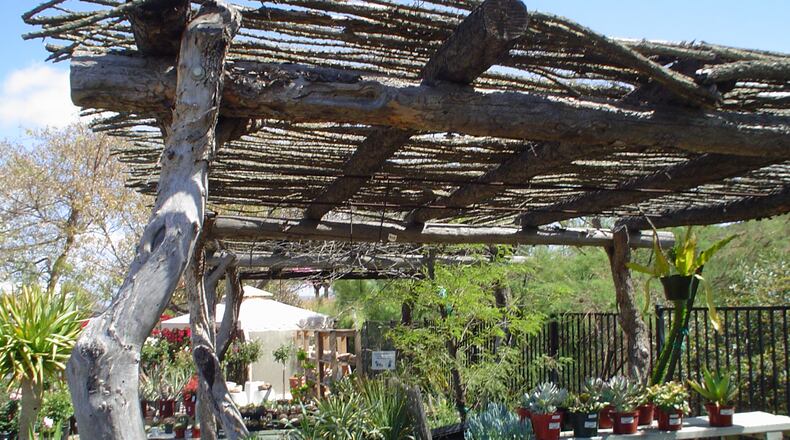In the desert, shade can be hard to come by. Trees for shade demand water throughout their entire lives, so growing for shade becomes difficult and costly. It also takes a lifetime to achieve. In the Southwest’s extremely dry climate, Native Americans built shade arbors to allow outdoor activity on unshaded sites. They used what was available: found wood, natural dead limbs, palm fronds, reeds and twigs.
To add more shade and to discourage insects, they cut oil-rich branches of pungent native herbs. They’d pile them onto the top of the structure for the summer months to increase shade density. The natural oils evaporating into the air below helped repel mosquitoes and flies in work areas.
In the desert, old desert tamarisk trees are often cut hard or pollarded, yielding a lot of straight, strong branches. The same applies to fruitless mulberry and others. Normally the cut limbs are used for firewood, chipped or end up in the dump. Inquire with tree trimmers for opportunities to salvage full-length limbs close to home. Save them the trouble of cutting and hauling in exchange.
An excellent example of a perfect shade structure comes from remote oasis in the Mojave Desert. Here at the oasis grow ancient native fan palms that yield a never-ending supply of fronds. In this case, palm fronds would make the best shade thatch.
A great design for everyone to create personal shade requires just six railroad ties, poles, wire fence and palm fronds. Any locally available thatch material may be substituted. Set four posts in holes with concrete, then place the cross ties on top and secure. This makes it strong enough to support a hammock. Then a framework of poles across the top are screwed into the ties at both ends. On top of the poles they rolled out welded wire mesh attached with tie wire or U nails. Next are the palm fronds layered like shingles, each one wired to the mesh. Finally, lay another identical wire mesh on top so the wind doesn’t batter, loosen or fold the fronds. Tie and screw it all down with wire and enjoy.
Tree branches and poles as well as fresh flexible willow make some of the best sources for all sorts of open air living solutions from fences to privacy screens and windbreaks. The pole diameter and density determines the percentage of shade you achieve. The gaps let heat rise instead of accumulating under a solid roof. Wet it down on a breezy day and you’ll have evaporative cooling.
This is also a great way to achieve privacy where multistory buildings look down on your yard, or with nosy neighbors. There’s no cheaper, better way to create private space for relaxation and dining suitable for fun string lights and a hammock.
Once you have the basic materials, this is not a difficult project. Whenever possible, use wood screws for stability as salvage wood shrinks and swells with the seasons. When friends visit, let them discover life made simple with pure, original creations. Don’t spoil the mirage with red-stained garden beams or the plastic connectors or anything that whispers “mass produced” to wake you from this dream scenario.
These structures are important for the getaway garden, staycations and as an impromptu outdoor office. They blend into old adobe, log-style cabins and field stone cottages. Nothing you see is mass produced, so it’s an entirely new creation made of locally indigenous materials. In the right setting, it can also make a fine open air work space for artists and craftsmen. The air movement and shade as well as protection easily morphs into an airy outdoor studio.
Take your cues from the depths of the Mojave, where escaping summer heat is a full-time job. Without trees, adopt the local solution for outdoor living inspired by the desert tribes, who perfected the art of throwing shade many eons ago.
———
Maureen Gilmer is an author, horticulturist and landscape designer. Learn more at www.MoPlants.com
About the Author
Keep Reading
The Latest
Featured

